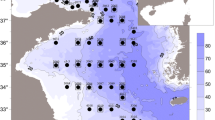Abstract
A new method to single out the environmental factor limiting the life of any macrobenthic animal under stressed condition is proposed. The method is based on the assumption that the influence of each environmental factor on the life of a species can be expressed by an S-shaped function having lethal, limiting and non-limiting ranges, and the combined effect of several environmental factors is expressed by a multiple of these functions. To single out a lethal factor, we used the cumulative curve of abundance arranged in the order of each environmental factor. Comparison of these curves enables us to identify the most effective environmental factor limiting the life of a particular species and determine its effective range. Determination can be made from a single field observation without recourse to specially prepared experimental data if a sufficiently extensive survey was made in a field observation. The method was applied to the field data obtained from 248 stations at Lake Shinji, Japan, in the summer of 1982.
Similar content being viewed by others
Literature cited
Fauchald, K., Jumars, P. (1979). The diet of worms: a study of polychaete feeding guilds. Oceanogr. mar. Biol. A. Rev. 17: 193–284
Gray, J. S. (1974). Animal-sediment relationships. Oceanogr. mar. Biol. A. Rev. 12: 223–261
Imajima, M. (1972). Review of the annelid worms of the family Nereidae of Japan, with descriptions of five new species or subspecies. Bull. natn. Sci. Mus. Tokyo 15: 37–153
Imajima, M., Hartman, O. (1964). The polychaetous annelids of Japan. Occ. Pap. All Hancock Fdn 26: 1–237
Ishitobi, Y., Kamiya, H., Hayashi, K., Gomyoda, M. (1989). The tidal exchange in Lake Shinji under low discharge conditions. Jap. J. Limnol. 50: 105–113
Pearson, T. H., Rosenberg, R. (1978). Macrobenthic succession in relation to organic enrichment and pollution of the environment. Oceanogr. mar. Biol. A. Rev. 16: 229–311
Sanders, H. L. (1958). Benthic studies in Buzzards Bay. I. Animalsediment relationships. Limnol. Oceanogr. 3: 245–258
Tsuchiya, M., Kurihara, Y. (1976). Studies on the distribution of the macrobenthos with special reference ot the movement of the fine particle at Gamo lagoon, Miyagi Prefecture. Physiol. Ecol., Jap. 17: 145–151
Warwick, R. M. (1986). A new method for detecting pollution effects on marine macrobenthic communities. Mar. Biol. 92: 557–562
Yamamuro, M. (1986). Distributions of Polychaete, Gastropoda and Bivalvia in brackish coastal lagoon in Japan, and environmental conditions as determinants. Masters Thesis Faculty of Science, University of Tokyo
Yamamuro, M. (1987). Macrobenthic faunas of two brackish lagoons with different salinity in Kamikoshiki Island, Kagoshima Prefecture. Japan. J. Limnol. 48: 177–186
Author information
Authors and Affiliations
Additional information
Communicated by M. Anraku, Tokyo
Rights and permissions
About this article
Cite this article
Yamamuro, M., Nakamura, M. & Nishimura, M. A method for detecting and identifying the lethal environmental factor on a dominant macrobenthos and its application to Lake Shinji, Japan. Mar. Biol. 107, 479–483 (1990). https://doi.org/10.1007/BF01313432
Accepted:
Issue Date:
DOI: https://doi.org/10.1007/BF01313432



